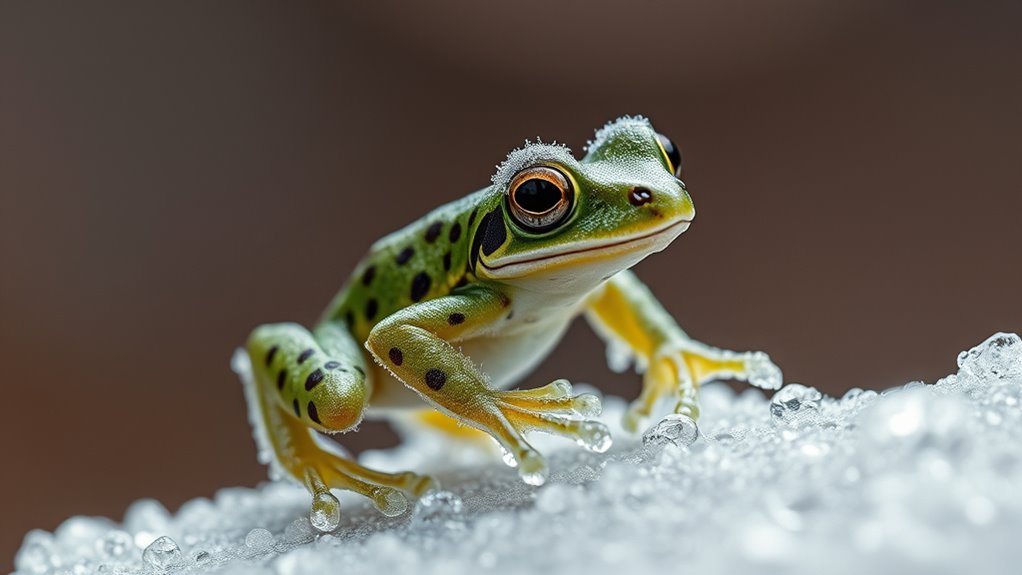The wood frog, found in North American forests and wetlands, is famous for surviving extreme cold by freezing solid during winter. It produces natural antifreeze like glucose to control ice formation outside its cells and stays dormant beneath leaf litter. Its unique adaptations allow it to endure temperatures well below freezing. If you’re curious about how this tiny creature manages such a remarkable feat, you’ll discover fascinating details about its survival secrets as you go further.
Key Takeaways
- The wood frog can survive freezing temperatures by producing natural antifreeze like glucose to protect its cells.
- It remains on land, hiding in leaf litter and moss, unlike water-dwelling frogs, and breeds in temporary vernal pools.
- During winter, the frog’s cells activate mitochondrial genes and produce cryoprotectants to withstand ice formation.
- Its extraordinary freeze-tolerance makes it a model for scientific research on cryopreservation and cellular survival.
- Protecting its wetland habitats ensures the survival of this remarkable species and its ecological role.
The Unique Habitat of the Wood Frog
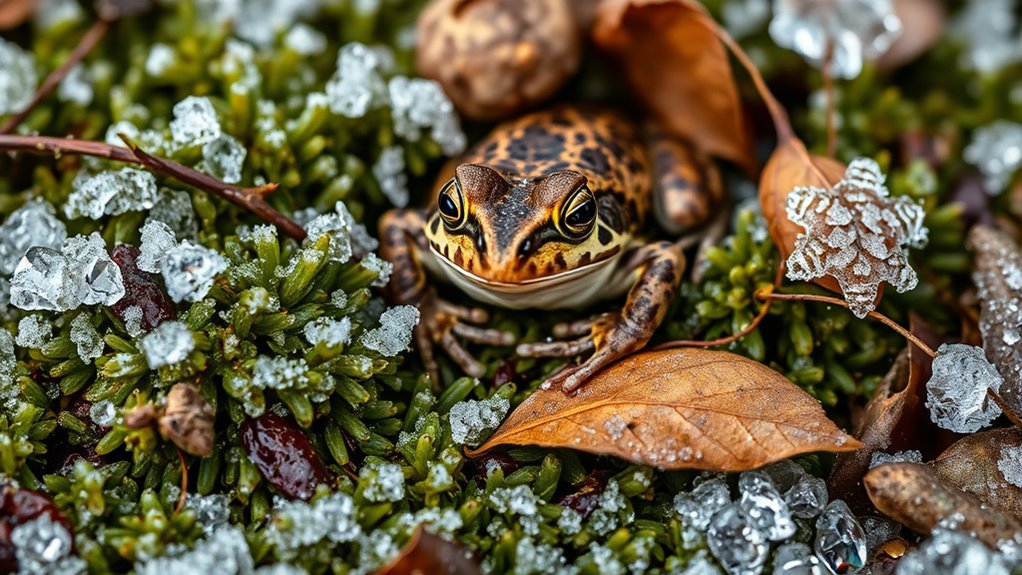
The wood frog (*Rana sylvatica*) has a remarkable habitat that sets it apart from most amphibians. You’ll find it in North American forests and wetlands, stretching from the northeastern United States all the way to Alaska, even beyond the Arctic Circle. These frogs prefer woodland areas and temporary ponds, especially vernal pools that fill with water in early spring. During winter, you’ll often see them brumating beneath leaf litter or soil, where they endure freezing temperatures. Unlike other frogs that stay in water, they stay on land, hiding in leaf litter and moss. Their habitat is rich in predators like snakes, raccoons, and birds, making survival a constant challenge. Protecting these habitats is essential for maintaining healthy populations of this extraordinary species. Understanding their habitat helps highlight the importance of conservation efforts for these resilient frogs. Additionally, their ability to survive freezing temperatures is a rare adaptation among amphibians, emphasizing the need to preserve their unique adaptations. The delicate balance of their habitat underscores the significance of wetland conservation for their ongoing survival. Moreover, recent studies have shown that preserving native ecosystems is vital for supporting the biodiversity of amphibians like the wood frog.
How the Frog Survives Freezing Temperatures
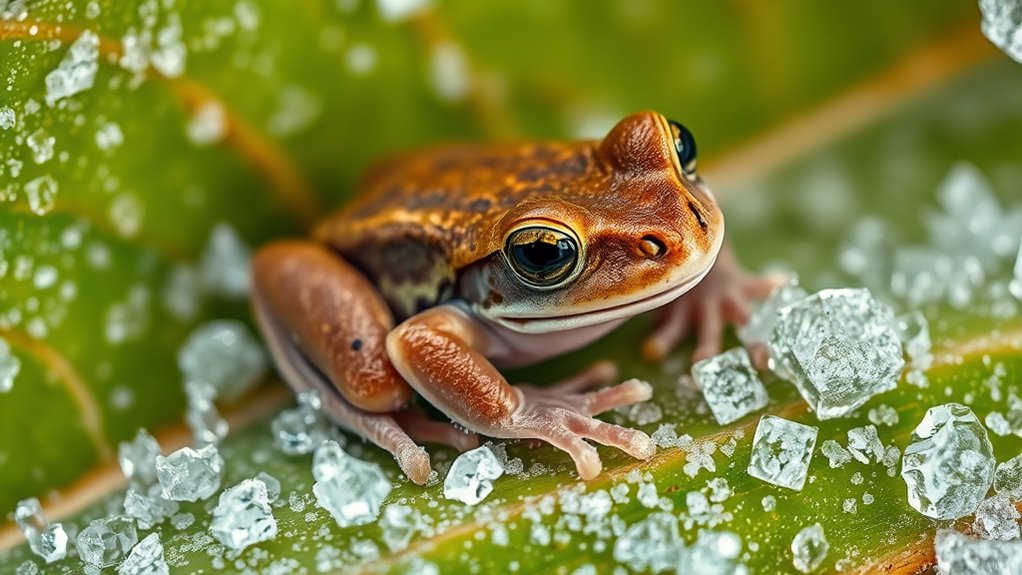
You might wonder how the wood frog survives freezing temperatures. It produces high levels of natural antifreeze in its body, mainly glucose, to protect its cells. Additionally, the frog controls ice formation, localizing it outside cells to prevent damage during winter. The process is similar to how self-watering features impact the health of indoor plants by maintaining consistent moisture levels and preventing root rot. This biological adaptation allows the frog to endure prolonged periods of cold, much like how comfort solutions for sofa beds improve sleep comfort during colder months. Furthermore, this remarkable survival strategy is an excellent example of how adaptations enable wildlife to thrive in extreme environments.
Natural Antifreeze Production
During winter, wood frogs face freezing temperatures that would typically be lethal, but they survive thanks to their ability to produce natural antifreeze compounds. They generate high concentrations of glucose in their liver, which circulates throughout their bodies, acting as a cryoprotectant. This glucose lowers the freezing point of their body fluids, preventing ice from damaging cells. Additionally, they produce urea, which helps stabilize cell structures during freezing. These substances work together to control ice formation, ensuring it occurs outside cells where it’s less harmful. The frogs also produce ice-nucleating proteins that direct ice growth to extracellular spaces, avoiding intracellular freezing. This natural antifreeze system is an example of biological cryoprotection, allowing them to withstand ice formation while remaining alive and functional through the coldest months. Moreover, their ability to regulate water and solute movement in response to freezing conditions exemplifies the remarkable adaptations of freeze tolerance.
Controlled Ice Formation
Wood frogs have developed a sophisticated system to regulate ice formation within their bodies, allowing them to survive freezing temperatures. They carefully manage where and how ice forms, preventing cellular damage. This process involves several key strategies:
- Ice-nucleating agents trigger ice development only outside cells, keeping intracellular spaces unfrozen.
- Glucose and other cryoprotectants concentrate in tissues, acting as natural antifreeze and controlling ice growth.
- Ice crystals form gradually in extracellular spaces, avoiding abrupt damage.
- The frog’s tissues vitrify, turning into a glass-like state that prevents harmful crystal expansion.
- The regulation of ice formation is supported by advanced detection methods, which help the frogs monitor and respond to temperature changes effectively.
These mechanisms work together to ensure ice forms in a controlled manner, halting bodily functions without destroying cells. This remarkable control allows the frog to endure and recover from prolonged freezing conditions.
The Science Behind Cryoprotectants and Ice Management

Cryoprotectants play an essential role in enabling wood frogs to survive freezing temperatures by preventing cellular damage caused by ice formation. When temperatures drop, the frogs produce high levels of glucose and urea, which act as natural antifreeze agents. These molecules stabilize cell membranes and regulate water movement, reducing dehydration and preventing lethal ice crystals inside cells. They also help control ice growth by localizing ice formation to extracellular spaces, ensuring that intracellular fluids remain unfrozen and safe. This process, known as vitrification, transforms bodily fluids into a glass-like state, avoiding damaging crystallization. By managing ice formation and protecting cellular integrity, cryoprotectants enable the frogs to endure prolonged freezing, then thaw and resume normal life functions in spring. Efficient ice management is crucial for the survival of these remarkable creatures in extreme cold environments. Additionally, the production of cryoprotectants is tightly regulated and increases significantly during the onset of freezing conditions to optimize survival chances. Moreover, recent studies have highlighted the importance of molecular stabilization in maintaining cell viability during extreme stress. Furthermore, ongoing research suggests that understanding these natural processes could inform advancements in cryopreservation techniques for medical applications.
Cellular Changes During Freezing and Thawing
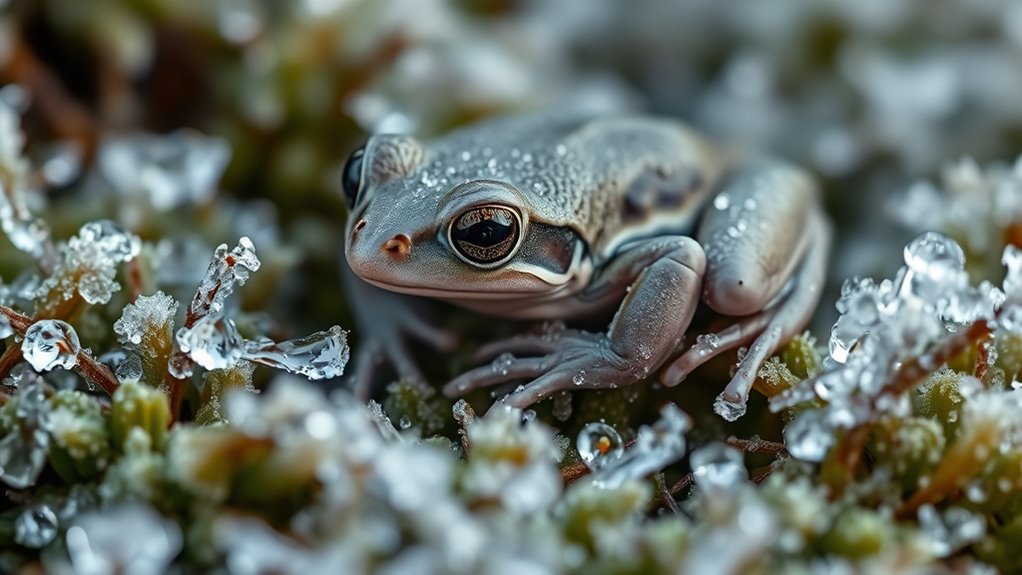
As freezing begins, your cells activate mitochondrial genes like *ATP 6/8* and *ND4* to maintain energy during oxygen deprivation. Cryoprotectants such as glucose stabilize cell structures and prevent damage from dehydration and ice formation. When thawing starts, gene expression shifts again, supporting cellular repair and restoring normal functions after the stress of freezing. Additionally, understanding cellular resilience mechanisms can help improve preservation techniques in biological research. This adaptive response showcases the remarkable stress response capabilities of cells in extreme conditions. Moreover, research into cellular metabolic adjustments during freezing can provide insights into enhancing cryopreservation methods for various biological specimens, drawing on advanced techniques used in biotechnological applications. Recognizing the importance of predictive analytics in biological data can further refine our approaches to optimizing preservation processes.
Mitochondrial Gene Upregulation
- Genes increase production of proteins essential for energy and repair.
- Mitochondria shift to produce minimal reactive oxygen species.
- Enhanced gene activity supports cell membrane stability.
- Mitochondrial regulation prevents energy collapse during prolonged freeze.
- Dog breeds can influence mitochondrial function and resilience during stress, aiding survival during extreme conditions.
- Additionally, the upregulation of mitochondrial biogenesis helps cells adapt to and recover from the stresses of freezing and thawing.
- Understanding metabolic pathways provides insight into how cells efficiently manage energy during extreme conditions, highlighting the importance of cellular metabolism in survival mechanisms.
Cryoprotectant Role in Cells
During freezing, cells in the wood frog activate the production of small molecules known as cryoprotectants, which play a critical role in safeguarding cellular integrity. These molecules, primarily glucose and urea, help prevent damage from ice formation and dehydration. As extracellular ice develops, cryoprotectants stabilize cell membranes and reduce osmotic stress by controlling water movement. They also increase the solution’s viscosity, slowing ice crystal growth that could puncture cell structures. During thawing, cryoprotectants facilitate controlled rehydration, minimizing cellular swelling and rupture. Their presence ensures that cells can withstand the extreme dehydration and rewarming stresses associated with freezing and thawing. By maintaining cell stability and function, cryoprotectants are essential for the frog’s remarkable ability to survive complete body freezing.
Gene Expression During Thaw
Have you ever wondered how cells adapt at the genetic level when a wood frog thaws from its frozen state? During thawing, gene expression shifts rapidly to restore normal function. You see, cells activate specific genes to repair damage, restart metabolism, and protect against oxidative stress.
- Genes encoding mitochondrial proteins ramp up to restore energy production.
- Antioxidant and chaperone genes increase to repair protein damage.
- Cryoprotectant regulation adjusts to stabilize cell structures.
- Stress-response genes are triggered to manage sudden oxygen and temperature changes.
These changes happen swiftly, allowing the frog’s cells to recover from extended freezing. The genetic response ensures essential functions restart smoothly, helping the frog emerge healthy and ready to continue its life cycle.
The Role of Mitochondria in Cold Survival
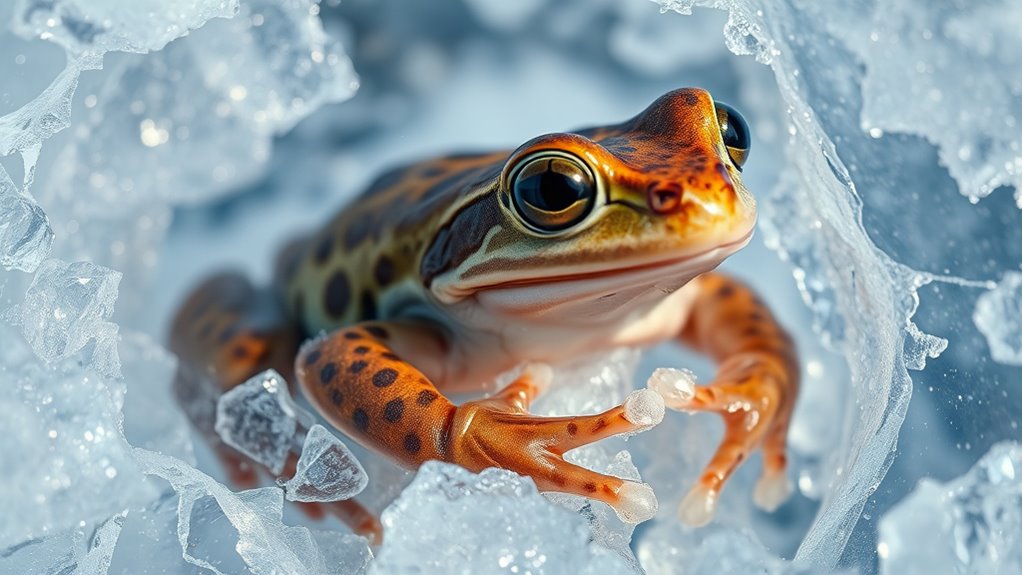
Mitochondria play a crucial role in helping wood frogs survive extreme cold by adjusting their energy production and maintaining cellular health during freezing conditions. When temperatures drop and oxygen availability decreases, mitochondria modify their activity to reduce energy consumption, preventing damage from ischemia. They upregulate specific genes, like *ATP 6/8*, *ND4*, and *16S* RNA, to sustain energy production during prolonged anoxia. These adaptations help cells endure the frozen state without losing essential functions. Additionally, mitochondria enhance antioxidant defenses to combat oxidative stress caused by freeze-thaw cycles. By regulating gene expression and conserving energy, mitochondria ensure that cells remain viable during months of dormancy, enabling the frog to thaw and resume normal activity when conditions improve.
Behavioral Strategies for Winter Survival

Wood frogs employ a range of behavioral strategies to survive harsh winter conditions. You’ll find them brumating under leaf litter or hiding in soil, where they remain largely inactive. They often choose vernal ponds or damp forest floors to hibernate, avoiding extreme cold and dehydration. These frogs anticipate winter’s arrival by burrowing deep into the ground or under fallen leaves, creating a protective microclimate around themselves.
- Concealed beneath layers of leaf litter, blending seamlessly with their environment
- Immobile in underground burrows, shielded from freezing air
- Remaining dormant in moist, insulated soil during the coldest months
- Quickly awakening with the first warmth of spring, ready to resume activity
Their behavioral adaptations minimize exposure and prepare them for the freezing process, increasing survival chances.
The Ecological Importance of Wood Frogs

You can see how essential wood frogs are by noticing their role as indicators of ecosystem health. Their breeding in temporary ponds helps maintain wetland balance and supports other species. Protecting these frogs means safeguarding the broader environment they help sustain.
Indicator of Ecosystem Health
Have you ever considered how the presence and activity of wood frogs can reveal the overall health of forest and wetland ecosystems? These frogs are early indicators because their breeding and survival depend on pristine habitats. Their breeding in vernal ponds signals water quality and availability, while their population trends reflect habitat stability. When wood frogs thrive, it suggests a balanced ecosystem with healthy food webs and minimal pollution. Conversely, declines hint at environmental stressors like habitat loss or contamination.
- Lush, undisturbed vernal ponds teeming with frog eggs and tadpoles
- Frogs calling loudly in spring, indicating stable breeding conditions
- Healthy populations coexisting with diverse predators and plants
- Sudden drops in numbers signaling habitat degradation or pollution
Breeding in Temporary Ponds
During early spring, wood frogs seek out temporary ponds—also known as vernal pools—to breed and lay their eggs. These ponds fill with snowmelt and rain, providing a safe, predator-light environment perfect for their explosive breeding. You’ll notice males calling loudly to attract females, often within days of pond formation. Because vernal pools dry up by summer, these frogs have adapted to breed quickly, completing their egg, tadpole, and metamorphosis stages in just a few weeks. This rapid cycle minimizes exposure to predators and environmental threats. Their breeding in these ephemeral habitats helps maintain healthy amphibian populations and supports diverse aquatic ecosystems. Protecting vernal pools is crucial, as they serve as critical breeding grounds for wood frogs and many other species.
Challenges Facing Populations Today

Many populations today face a multitude of challenges that threaten their survival and well-being. Habitat loss due to deforestation, urbanization, and climate change reduces their living spaces and disrupts migration patterns. Pollution contaminates water, air, and soil, harming both humans and wildlife. Rising temperatures and unpredictable weather patterns create stressful conditions, especially for cold-adapted species. Overharvesting and invasive species further threaten native populations, pushing some toward extinction.
- Forests shrinking, leaving fewer places for animals to hide and breed
- Toxic chemicals accumulating in ecosystems, poisoning vulnerable species
- Sudden climate shifts causing habitat mismatches and food shortages
- Invasive species outcompeting native wildlife, disrupting delicate balances
What Humans Can Learn From the Wood Frog

The wood frog’s remarkable ability to survive freezing temperatures offers valuable lessons for human medicine and biological preservation. By studying how it produces natural antifreeze agents like glucose and manages ice formation, you can find ways to improve cryopreservation techniques. These frogs carefully control ice crystals to prevent cell damage, a strategy you could adapt for storing organs or tissues at low temperatures. Their cellular responses, such as upregulating protective genes during freezing, show how you might enhance cell survival in ischemic conditions. Additionally, understanding their antioxidant defenses and metabolic adjustments can inspire new treatments for protecting human tissues from oxidative stress. Overall, the frog’s freeze tolerance offers a blueprint for advancing organ preservation, improving transplant outcomes, and developing better methods to safeguard biological materials.
Protecting a Tiny but Vital Species
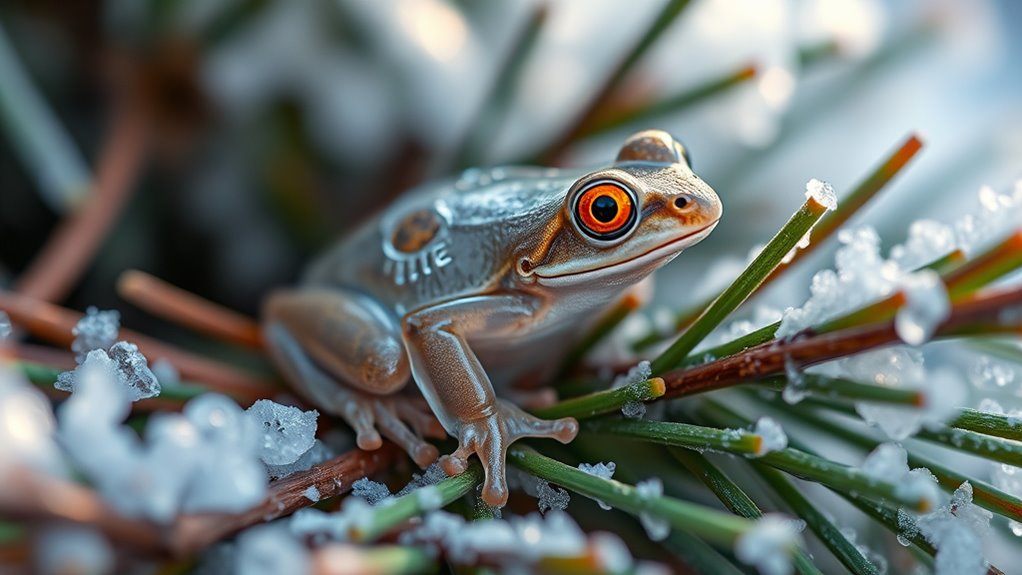
Protecting this tiny but pivotal species, the wood frog, is essential for maintaining healthy ecosystems and advancing scientific knowledge. By safeguarding their habitats, such as vernal ponds and surrounding woodlands, you help guarantee their survival and ecological role. These frogs serve as indicators of wetland health, signaling environmental stability. Efforts to prevent habitat destruction, pollution, and climate change are indispensable. Promoting awareness about their unique freeze-tolerance and breeding habits encourages conservation. You can support policies that protect biodiversity and restore degraded wetlands. Recognizing their importance helps preserve the balance of forest and wetland ecosystems, which benefits countless other species. Protecting the wood frog ensures ongoing scientific discoveries and ecological resilience for future generations.
- Imagine vibrant ponds teeming with tiny frogs calling loudly in spring.
- Visualize lush forests where frogs hide beneath fallen leaves and moss.
- Picture scientists studying these frogs’ remarkable freeze-tolerance in labs.
- Envision thriving wetlands that sustain diverse plant and animal life.
Frequently Asked Questions
How Does the Wood Frog Prevent Intracellular Ice Formation During Freezing?
You might wonder how the wood frog prevents intracellular ice formation during freezing. It produces high levels of glucose, acting as a natural antifreeze, which stabilizes cells and prevents ice crystals from forming inside. Additionally, it uses ice-nucleating agents to control where ice forms, keeping it extracellular. This combination of biochemical and physical strategies helps the frog survive extreme freezing without damaging its crucial cells.
What Specific Genes Are Activated in Frogs During Winter Freezing?
During winter freezing, you’ll find that the wood frog activates mitochondrial genes like *ATP 6/8*, *ND4*, and *16S* RNA. Imagine these genes as tiny switches turning on inside the frog’s cells, helping them survive the icy silence. They boost energy production, manage oxygen deprivation, and protect against oxidative stress, ensuring the frog’s cells stay resilient during months of frozen stillness.
How Long Can a Wood Frog Remain Frozen Before It Cannot Survive?
You should know that a wood frog can typically survive being frozen for up to six months, depending on the environmental conditions and the frog’s health. During this period, it remains in a state of suspended animation, with all essential functions halted. However, if the freezing duration exceeds this timeframe, the risk of cellular damage and death increases markedly, making survival unlikely.
Are There Other Species With Similar Freeze Tolerance Capabilities?
Yes, other species have freeze tolerance capabilities. For example, certain reptiles like the painted turtle can survive freezing during winter by producing antifreeze compounds. Some insects, such as the wood cockroach and freeze-tolerant beetles, also endure freezing temperatures. These animals share strategies like producing cryoprotectants and managing ice formation, allowing them to survive in extreme cold environments much like the wood frog does.
Can the Wood Frog’s Freezing Process Be Replicated for Medical Organ Preservation?
Yes, the wood frog’s freezing process can inspire medical organ preservation. You could develop cryoprotectant solutions mimicking their glucose-based antifreeze, reducing ice crystal formation during freezing. By understanding their cellular responses, you can improve vitrification techniques, preventing damage during storage. This approach might lead to longer preservation times for organs, making transplants more successful and expanding possibilities for organ transport and medical treatments.
Conclusion
You hold the key to this tiny survivor’s fate. Like a delicate crystal, the wood frog’s icy resilience reminds us of nature’s astonishing adaptability. By protecting this tiny champion, you safeguard a miracle of life that defies the cold, shining a light on nature’s hidden wonders. Let’s cherish and defend this frozen marvel, ensuring it continues to inspire awe and teach us the true meaning of resilience in the face of life’s harshest winters.
